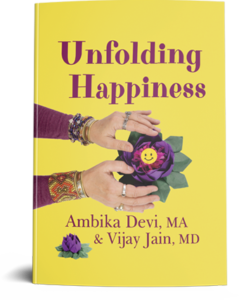Never miss an update!
Subscribe to Ambika’s Blog and receive news straight into your inbox!
Thank you for joining my newsletter
Check your email to confirm and receive a gift!

Beginners who are seeking to learn the art of meditation often encounter a hurdle disguised as a brick wall. What creates this is that they imagine meditation requires an arrival to a specific location. Allow me to clear the way for you right now. There is no destination. Meditation in not a location; it is a state of being.
There are even more confused ideas that I have witnessed. Often people mistaken the acts of focusing attention and searching for ideas as meditation. Though in the English language we often refer to the idea of focus as meditation—it is also important to understand that focus alone does not equal meditation.
Can focusing on something trip you into this fully relaxed state of body with an awake and aware mind? Yes, and there are many more ways that you can experience being there. In the state of meditation we are completely withdrawn from the body’s five senses of: Sight, touch, hearing, taste, and smell.
A great first step to understand this is to first get in touch with your five physical senses.

I am going to share some information from by second book, Unfolding Happiness, that you can try as a way to experience the cosmic components of the universe connected with these five physical body senses. It begins in the morning. Get up before the sun rises and go out for a walk. Look into the sky to absorb the elements of space along with the fire of the stars twinkling. Notice how the sounds of nature are abundant at this time of day. As light emerges on the horizon, you can listen to a chorus of birds beginning to sing. If you are near water listen to the changes in the sounds whether you are at the shoreline hearing waves crashing or by a creek listening to a trickling sound of water, dancing across stones, and pebbles. What does the morning air feel and tastes like? When the sun begins to appear it fills the vast emptiness of space with the fire element rising in the sky. Feel the warmth of the sunlight on your body, coupled with the sound of water and the support of the earth underfoot. Together these elements complete a full sensory experience.
It begins in the morning. Get up before the sun rises and go out for a walk. Look into the sky to absorb the elements of space along with the fire of the stars twinkling. Notice how the sounds of nature are abundant at this time of day. As light emerges on the horizon, you can listen to a chorus of birds beginning to sing. If you are near water listen to the changes in the sounds whether you are at the shoreline hearing waves crashing or by a creek listening to a trickling sound of water, dancing across stones, and pebbles. What does the morning air feel and tastes like? When the sun begins to appear it fills the vast emptiness of space with the fire element rising in the sky. Feel the warmth of the sunlight on your body, coupled with the sound of water and the support of the earth underfoot. Together these elements complete a full sensory experience.
You can purchase a copy of Unfolding Happiness, here.
Now that you’re more aware of your physical senses,
imagine what it would feel like to completely shut them out.
This is what happens when we meditate.
It is natural to want to know that you are doing it right. We learn through feedback from our senses as little children. But here, in the state of meditation there’s nothing to look for. Instead, we back up from the senses and become the witness of thought.
The directions to find the state of meditation in the ancient writing is to follow three simple steps.
They are:
1. Sit up straight.
2. Close your eyes.
3. Focus on your breath.
Let’s unpack this further as these simple directives can leave fingers scratching heads in wonder.
Sitting up straight helps to stack each vertebra of the spine in such a way that the vital fluids and nerve feed twisting in tiny on an off ramps, flows with greater ease and viscosity throughout the body. This also enables the rib-cage—along with its shroud of muscles—to move with more freedom during each inhalation and exhalation. Close your eyes when your in a quiet space sometime or pause if you are right now and dive inside of your body. Notice how your ribs move up and down like a handle on a bucket.
In addition to these directions, it is also important to be relaxed. Finding a comfortable seated position is vital. I have a video on my YouTube channel you can watch to learn the art of sitting in comfort, like a yogi. You can watch it here:
If you are seated in a chair, it is best to place your feet flat on the floor and your arms with your hands resting on your thighs. It doesn’t matter if your palms are facing upward or downward. That is something we can have a look at later. Also, try to avoid crossing your legs.
Now that we have figured out how to sit, next we are told to close our eyes. That’s simple enough however, we are able to detect light through our eyelids. I suggest if you feel fidgety to try placing a lightweight cover over your head so that your eyes are shrouded but not your nose. This helps to shut down the Limbic Cortex: The Lizard brain. This technique is going to be a game-changer for many of you.
In some translations of the ancient text we are then guided to place the attention on the tip of the nose or to cross the eyes. Other takes on what the ancient scripts say recommend crossing the eyes while lifting the inner gaze. I know, this is where it gets even more confusing.
What I suggest is imagine that you are relaxing and disappearing.
When thought-waves intrude—as they are known to, turn your focus to your breath.
Just begin to notice it.
At first, just watch your body breathing. Observe any aspect of your body breathing that captures your attention. Once you find this action, allow it to take you an an adventure to your nose. Begin to examine through sensations of the air coming into your nostrils followed by your exhalations and then your next breath.
Though these ideas can work for you, I have learned that a suggestion I have given thousands of students over the decades seems to work even better. This is to become aware of the inside front edges of your nostrils. Many tell me this works great because once they get in touch with this area, they are able to feel the coolness of the air during inhalations and the disappearing warmth of their exhalations.
Sometimes we just need to awaken the skin and nerves by touching these areas physically and tuning in with our imagination. Take a finger and massage the bottoms of each nostril opening. You can use a little bit of a pinching motion or light scraping. It is your nose, you know what it can take. Next be gentle and smooth the inside of the front edge. I know it looks like you’re picking your nose, so maybe don’t try this while listening to my podcast in traffic.
As a matter of fact, I don’t want you to try any of this while you’re driving. Instead, I prefer that you are comfortable and away from disturbances in a quiet place, so that you can fully focus on this process. Please let go of expectation. A wise teacher of mine said, Expectation is a recipe for disappointment.
When you are first setting out make a commitment to focus, just imagine you are going to stay put for three breaths. Just in case, set a timer for three minutes.
When you are ready for a further challenge here is something you can try
to prove what it means to be the witness of your thoughts.
Find your comfortable seated position as you did before with your eyes closed, ready to focus on your breath. Inside your imagination repeat the idea of the sound ॐAUM. You are going to do this for three minutes. Do your best to watch what happens.
Now that you are back, what probably happened is that you stayed focused on the sound and then at some point another idea flew in. It could have been a thought or a picture, an image—something came into your awareness. Maybe this flash took you down a trail or even into a rabbit hole. Were you able to return to the idea of the sound ॐAUM? Be honest with yourself, how did it go?
What this little experience proves is the sensation of watching, noticing and feeling what it means to be a witness.
You are not thought. You might have imagined that the idea of repeating the mantra was what was going to get you into the state of meditation. That is focal point, it is mindfulness. Instead, placing the mind on a focal-point gave you an opportunity to notice a thought came in. This came from the mind.
There exists only one mind.
It is unified.
Thought belongs to the one mind.
The mind is nothing more then a bundle of thoughts.
It is not inside of you.
We can change thought patterns. When we are experiencing negative thought, we can focus on a positive thought and keep repeating it. We can redirection attention. Positive thoughts always have the ability to take over negative thoughts. Where ever you focus your attention is your choice. It takes effort to notice what is really happening. You have a choice as to where you place your attention and how much effort you invest.
You could try laughter in any way that you can find it. Saturate your mind with cheerful and joyous thoughts. Acting as if helps. It is not a joke! Even pressing the corners of your mouth upward and holding them in that position helps. Another suggestion is to go outside and run a little. Breathe the air.
If you are serious about ending a difficult Thought-Loop and you need my support, I am here to help you. Together we can identify your unique Thought-Loop and I will help you create a formulae to get rid of it.
Here is what one of my clients had to say about this:
Ambika guided me to clear a nagging Thought-Loop with her depth of knowledge and skill. This helped me identify fears I had been holding concerning conflict with a family member. In our session she guided me to create what feels like a secret-password that instantly brings me a full sense of being grounded and knowing that I am safe, secure, and confident with the energy to move forward. I am grateful for working with this extraordinary coach.
Reach out to me, send me a message, Visit my calendar and Book Your Appointment with me now!
Do you Love what I’m doing and want to help support my mission? You can Send me a love donation here. I really appreciate it.
हरि ॐ तत् सत् Hari AUM Tat Sat,
Ambika Devi
SHARE ON SOCIAL MEDIA